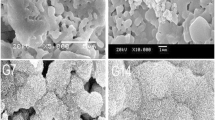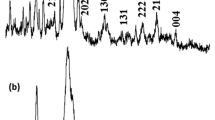Abstract
Hydroxyapatite is an ideal biomaterial for bone tissue engineering due to its biocompatibility and hemocompatibility which have been widely studied by many researchers. The incorporation of nanoporosity into hydroxyapatite could transform the biomaterial into an effective adsorbent for uremic toxins removal especially in artificial kidney system. However, the effect of nanoporosity incorporation on the hemocompatibility of hydroxyapatite has yet to be answered. In this study, nanoporous hydroxyapatite was synthesized using hydrothermal technique and its hemocompatibility was determined. Non-ionic surfactants were used as soft templates to create porosity in the hydroxyapatite. The presence of pure hydroxyapatite phase in the synthesized samples is validated by X-ray diffraction analysis and Fourier transform infrared spectroscopy. The TEM images show that the hydroxyapatite formed rod-like particles with the length of 21–90 nm and diameter of 11–70 nm. The hydroxyapatite samples exhibit BET surface area of 33–45 m2 g−1 and pore volume of 0.35–0.44 cm3 g−1. The hemocompatibility of the hydroxyapatite was determined via hemolysis test, platelet adhesion, platelet activation and blood clotting time measurement. The nanoporous hydroxyapatite shows less than 5% hemolysis, suggesting that the sample is highly hemocompatible. There is no activation and morphological change observed on the platelets adhered onto the hydroxyapatite. The blood clotting time demonstrates that the blood incubated with the hydroxyapatite did not coagulate. This study summarizes that the synthesized nanoporous hydroxyapatite is a highly hemocompatible biomaterial and could potentially be utilized in biomedical applications.










Similar content being viewed by others
References
Sarath Chandra V, Baskar G, Suganthi R, Elayaraja K, Ahymah Joshy M, Sofi Beaula W, et al. Blood compatibility of iron-doped nanosize hydroxyapatite and its drug release. ACS Appl Mater Inter. 2012;4:1200–10.
Swain SK, Sarkar D. Study of BSA protein adsorption/release on hydroxyapatite nanoparticles. Appl Surf Sci. 2013;286:99–103.
Palazzo B, Sidoti M, Roveri N, Tampieri A, Sandri M, Bertolazzi L, et al. Controlled drug delivery from porous hydroxyapatite grafts: an experimental and theoretical approach. Mat Sci Eng C Mater. 2005;25:207–13.
Kawasaki T, Ikeda K, Takahashi S, Kuboki Y. Further study of hydroxyapatite high‐performance liquid chromatography using both proteins and nucleic acids, and a new technique to increase chromatographic efficiency. Eur J Biochem. 1986;155:249–57.
Nayar S, Sinha M, Basu D, Sinha A. Synthesis and sintering of biomimetic hydroxyapatite nanoparticles for biomedical applications. J Mater Sci Mater Med. 2006;17:1063–8.
Cheah WK, Ishikawa K, Othman R, Yeoh FY. Nanoporous biomaterials for uremic toxin adsorption in artificial kidney systems: a review. J Biomed Mater Res B. 2017;105:1232–40.
Ooi CH, Ling YP, Pung SY, Yeoh FY. Mesoporous hydroxyapatite derived from surfactant-templating system for p-Cresol adsorption: physicochemical properties, formation process and adsorption performance. Powder Technol. 2019;342:725–34.
Byrappa K, Adschiri T. Hydrothermal technology for nanotechnology. Prog Cryst Growth Ch Charact Mater. 2007;53:117–66.
Iyyappan E, Wilson P, Sheela K, Ramya R. Role of triton X-100 and hydrothermal treatment on the morphological features of nanoporous hydroxyapatite nanorods. Mat Sci Eng C Mater. 2016;63:554–62.
Wang Y, Zhang S, Wei K, Zhao N, Chen J, Wang X. Hydrothermal synthesis of hydroxyapatite nanopowders using cationic surfactant as a template. Mater Lett. 2006;60:1484–7.
de GJ, Soler-Illia AA, Crepaldi EL, Grosso D, Sanchez C. Block copolymer-templated mesoporous oxides. Curr Opin Colloid In. 2003;8:109–26.
Seyfert UT, Biehl V, Schenk J. In vitro hemocompatibility testing of biomaterials according to the ISO 10993-4. Biomol Eng. 2002;19:91–96.
Puvvada N, Panigrahi PK, Pathak A. Room temperature synthesis of highly hemocompatible hydroxyapatite, study of their physical properties and spectroscopic correlation of particle size. Nanoscale. 2010;2:2631–8.
Pal K, Pal S. Development of porous hydroxyapatite scaffolds. Mater Manuf Process. 2006;21:25–328.
Radha G, Balakumar S, Venkatesan B, Vellaichamy E. Evaluation of hemocompatibility and in vitro immersion on microwave-assisted hydroxyapatite–alumina nanocomposites. Mater Sci Eng C Mater. 2015;50:143–50.
Laranjeira MS, Moço A, Ferreira J, Coimbra S, Costa E, Santos-Silva A, et al. Different hydroxyapatite magnetic nanoparticles for medical imaging: Its effects on hemostatic, hemolytic activity and cellular cytotoxicity. Colloid Surf B. 2016;146:363–74.
Kramer ER, Morey AM, Staruch M, Suib SL, Jain M, Budnick JI, et al. Synthesis and characterization of iron-substituted hydroxyapatite via a simple ion-exchange procedure. J Mater Sci. 2013;48:665–73.
Lew KS, Othman R, Yeoh FY. Synthesis and characterization of mesoporous hydroxyxapatite. Adv Sci Tech. 2010;63:152–7.
Jadalannagari S, Deshmukh K, Ramanan SR, Kowshik M. Antimicrobial activity of hemocompatible silver doped hydroxyapatite nanoparticles synthesized by modified sol–gel technique. Appl Nanosci. 2014;4:133–41.
Pramanik N, Mohapatra S, Alam S, Pramanik P. Synthesis of hydroxyapatite/poly (vinyl alcohol phosphate) nanocomposite and its characterization. Polym Compos. 2008;29:429–36.
Amarnath LP, Srinivas A, Ramamurthi A. In vitro hemocompatibility testing of UV-modified hyaluronan hydrogels. Biomaterials. 2006;27:1416–24.
Motlagh D, Yang J, Lui KY, Webb AR, Ameer GA. Hemocompatibility evaluation of poly (glycerol-sebacate) in vitro for vascular tissue engineering. Biomaterials. 2006;27:4315–24.
Mirhosseini MM, Haddadi-Asl V, Zargarian SS. Fabrication and characterization of polymer–ceramic nanocomposites containing pluronic F127 immobilized on hydroxyapatite nanoparticles. RSC Adv. 2016;6:80564–75.
Karolewicz B, Górniak A, Owczarek A, Żurawska-Płaksej E, Piwowar A, Pluta J. Thermal, spectroscopic, and dissolution studies of ketoconazole–Pluronic F127 system. J Therm Anal Calorim. 2014;115:2487–93.
Prabhu SM, Meenakshi S. Synthesis of surface coated hydroxyapatite powders for fluoride removal from aqueous solution. Powder Technol. 2014;268:306–15.
Kolanthai E, Ganesan K, Epple M, Kalkura SN. Synthesis of nanosized hydroxyapatite/agarose powders for bone filler and drug delivery application. Mater Today Comm. 2016;8:31–40.
Sanosh K, Chu MC, Balakrishnan A, Lee YJ, Kim T, Cho SJ. Synthesis of nano hydroxyapatite powder that simulate teeth particle morphology and composition. Curr Appl Phys. 2009;9:1459–62.
Zhao Y, Loo S, Chen Y, Boey F, Ma J. In situ SAXRD study of sol–gel induced well‐ordered mesoporous bioglasses for drug delivery. J Biomed Mater Res A. 2008;85:1032–42.
Acknowledgements
The authors would like to acknowledge the financial support from the Universiti Sains Malaysia, Ministry of Education (MOE, Malaysia) and MyBrain 15 scholarship program. Highest gratitude is expressed for the technical support provided by the staff from the Centre of Research Laboratory (a division of School of Medical Sciences), Universiti Sains Malaysia.
Author information
Authors and Affiliations
Corresponding author
Ethics declarations
Conflict of interest
The authors declare that they have no conflict of interest.
Additional information
Publisher’s note: Springer Nature remains neutral with regard to jurisdictional claims in published maps and institutional affiliations.
Rights and permissions
About this article
Cite this article
Ooi, CH., Ling, Y.P., Abdullah, W.Z. et al. Physicochemical evaluation and in vitro hemocompatibility study on nanoporous hydroxyapatite. J Mater Sci: Mater Med 30, 44 (2019). https://doi.org/10.1007/s10856-019-6247-5
Received:
Accepted:
Published:
DOI: https://doi.org/10.1007/s10856-019-6247-5




